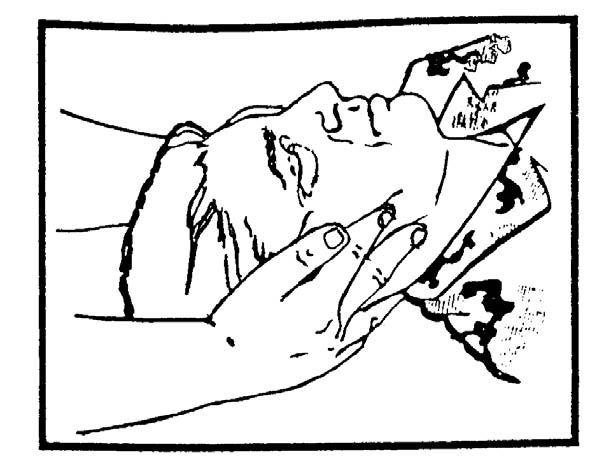Treating Fractures in the Field
Lesson 2: Spinal
Injuries
Section II: Immobilizing a Suspected Spinal Injury
2-5
Section II. IMMOBILIZING A SUSPECTED SPINAL INJURY
2-5. IMMOBILIZING A CASUALTY'S NECK WITH CASUALTY LYING DOWN
After making sure the casualty is breathing and all severe bleeding has been controlled, immobilize the casualty's spine. If possible, take measures to immobilize the casualty's neck before placing the casualty on a spine board. The following procedures assume the casualty is lying on his back and you have at least one other person to assist you. If you are the only medical person available, you should apply traction and supervise the application of the cervical collar to the casualty's neck.
a. Apply Manual Traction. Immobilize the casualty's head and neck by applying gentle manual traction.
(1) Kneel behind the casualty's head, facing the casualty.
(2) If needed, gently remove the casualty's helmet.
CAUTION: Only remove a helmet if it is necessary to treat an airway problem or
interferes with proper spinal immobilization.
(3) Place your hands on the sides of the casualty's head with your palms over the casualty's ears and your fingers supporting the casualty's mandible (jaw) as shown in figure 2-4.
(4) Pull back slightly to apply gentle traction. Maintain the traction until the casualty has been secured to the spine board.
Figure 2-4. Applying manual traction to a casualty's head (casualty on his back).
b. Apply Cervical Collar. A cervical collar is a rigid device that, when properly placed around the casualty's neck, prevents the casualty from bending his neck. It also provides support to the jaw, thus helping to immobilize the casualty's head. If a cervical collar is available, have your assistant apply the collar to the casualty's neck. If a cervical collar is not available, improvise a collar from a SAM splint or from material such as a folded towel, T-shirt, or field jacket. The following procedures can be used to improvise a cervical collar from a towel or other materials at hand.
NOTE: Prior to applying the cervical collar you should assess the casualty's neck for
step off’s, jugular vein distention, and tracheal deviation.
(1) Fold the material so it can be slipped under the casualty's neck.
(2) Slide one end of the folded material under the casualty's neck.
(3) Wrap the material around the casualty's neck without moving his head or neck.
(4) Fasten the material in place using pins, tape, or a cravat.
(5) Check the collar for tightness. It should support the neck without interfering with the casualty's breathing.
c. Place Casualty on Long Spine Board. Place and secure the casualty to a long spine board using the procedures given in paragraph 2-6 or paragraph 2-7.


